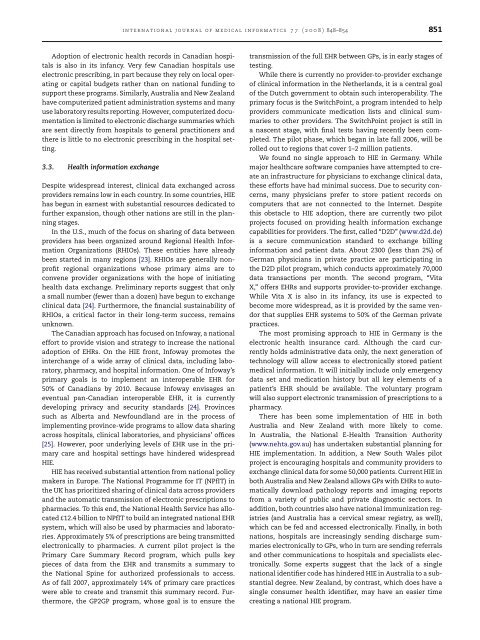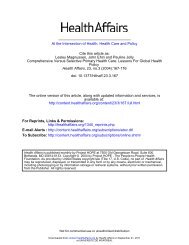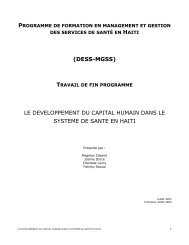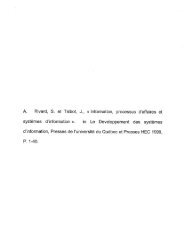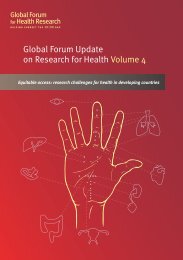The use of health information technology in seven nations
The use of health information technology in seven nations
The use of health information technology in seven nations
- No tags were found...
Create successful ePaper yourself
Turn your PDF publications into a flip-book with our unique Google optimized e-Paper software.
<strong>in</strong>ternational journal <strong>of</strong> medical <strong>in</strong>formatics 77 (2008) 848–854 851Adoption <strong>of</strong> electronic <strong>health</strong> records <strong>in</strong> Canadian hospitalsis also <strong>in</strong> its <strong>in</strong>fancy. Very few Canadian hospitals <strong>use</strong>electronic prescrib<strong>in</strong>g, <strong>in</strong> part beca<strong>use</strong> they rely on local operat<strong>in</strong>gor capital budgets rather than on national fund<strong>in</strong>g tosupport these programs. Similarly, Australia and New Zealandhave computerized patient adm<strong>in</strong>istration systems and many<strong>use</strong> laboratory results report<strong>in</strong>g. However, computerized documentationis limited to electronic discharge summaries whichare sent directly from hospitals to general practitioners andthere is little to no electronic prescrib<strong>in</strong>g <strong>in</strong> the hospital sett<strong>in</strong>g.3.3. Health <strong><strong>in</strong>formation</strong> exchangeDespite widespread <strong>in</strong>terest, cl<strong>in</strong>ical data exchanged acrossproviders rema<strong>in</strong>s low <strong>in</strong> each country. In some countries, HIEhas begun <strong>in</strong> earnest with substantial resources dedicated t<strong>of</strong>urther expansion, though other <strong>nations</strong> are still <strong>in</strong> the plann<strong>in</strong>gstages.In the U.S., much <strong>of</strong> the focus on shar<strong>in</strong>g <strong>of</strong> data betweenproviders has been organized around Regional Health InformationOrganizations (RHIOs). <strong>The</strong>se entities have alreadybeen started <strong>in</strong> many regions [23]. RHIOs are generally nonpr<strong>of</strong>itregional organizations whose primary aims are toconvene provider organizations with the hope <strong>of</strong> <strong>in</strong>itiat<strong>in</strong>g<strong>health</strong> data exchange. Prelim<strong>in</strong>ary reports suggest that onlya small number (fewer than a dozen) have begun to exchangecl<strong>in</strong>ical data [24]. Furthermore, the f<strong>in</strong>ancial susta<strong>in</strong>ability <strong>of</strong>RHIOs, a critical factor <strong>in</strong> their long-term success, rema<strong>in</strong>sunknown.<strong>The</strong> Canadian approach has foc<strong>use</strong>d on Infoway, a nationaleffort to provide vision and strategy to <strong>in</strong>crease the nationaladoption <strong>of</strong> EHRs. On the HIE front, Infoway promotes the<strong>in</strong>terchange <strong>of</strong> a wide array <strong>of</strong> cl<strong>in</strong>ical data, <strong>in</strong>clud<strong>in</strong>g laboratory,pharmacy, and hospital <strong><strong>in</strong>formation</strong>. One <strong>of</strong> Infoway’sprimary goals is to implement an <strong>in</strong>teroperable EHR for50% <strong>of</strong> Canadians by 2010. Beca<strong>use</strong> Infoway envisages aneventual pan-Canadian <strong>in</strong>teroperable EHR, it is currentlydevelop<strong>in</strong>g privacy and security standards [24]. Prov<strong>in</strong>cessuch as Alberta and Newfoundland are <strong>in</strong> the process <strong>of</strong>implement<strong>in</strong>g prov<strong>in</strong>ce-wide programs to allow data shar<strong>in</strong>gacross hospitals, cl<strong>in</strong>ical laboratories, and physicians’ <strong>of</strong>fices[25]. However, poor underly<strong>in</strong>g levels <strong>of</strong> EHR <strong>use</strong> <strong>in</strong> the primarycare and hospital sett<strong>in</strong>gs have h<strong>in</strong>dered widespreadHIE.HIE has received substantial attention from national policymakers <strong>in</strong> Europe. <strong>The</strong> National Programme for IT (NPfIT) <strong>in</strong>the UK has prioritized shar<strong>in</strong>g <strong>of</strong> cl<strong>in</strong>ical data across providersand the automatic transmission <strong>of</strong> electronic prescriptions topharmacies. To this end, the National Health Service has allocated£12.4 billion to NPfIT to build an <strong>in</strong>tegrated national EHRsystem, which will also be <strong>use</strong>d by pharmacies and laboratories.Approximately 5% <strong>of</strong> prescriptions are be<strong>in</strong>g transmittedelectronically to pharmacies. A current pilot project is thePrimary Care Summary Record program, which pulls keypieces <strong>of</strong> data from the EHR and transmits a summary tothe National Sp<strong>in</strong>e for authorized pr<strong>of</strong>essionals to access.As <strong>of</strong> fall 2007, approximately 14% <strong>of</strong> primary care practiceswere able to create and transmit this summary record. Furthermore,the GP2GP program, whose goal is to ensure thetransmission <strong>of</strong> the full EHR between GPs, is <strong>in</strong> early stages <strong>of</strong>test<strong>in</strong>g.While there is currently no provider-to-provider exchange<strong>of</strong> cl<strong>in</strong>ical <strong><strong>in</strong>formation</strong> <strong>in</strong> the Netherlands, it is a central goal<strong>of</strong> the Dutch government to obta<strong>in</strong> such <strong>in</strong>teroperability. <strong>The</strong>primary focus is the SwitchPo<strong>in</strong>t, a program <strong>in</strong>tended to helpproviders communicate medication lists and cl<strong>in</strong>ical summariesto other providers. <strong>The</strong> SwitchPo<strong>in</strong>t project is still <strong>in</strong>a nascent stage, with f<strong>in</strong>al tests hav<strong>in</strong>g recently been completed.<strong>The</strong> pilot phase, which began <strong>in</strong> late fall 2006, will berolled out to regions that cover 1–2 million patients.We found no s<strong>in</strong>gle approach to HIE <strong>in</strong> Germany. Whilemajor <strong>health</strong>care s<strong>of</strong>tware companies have attempted to createan <strong>in</strong>frastructure for physicians to exchange cl<strong>in</strong>ical data,these efforts have had m<strong>in</strong>imal success. Due to security concerns,many physicians prefer to store patient records oncomputers that are not connected to the Internet. Despitethis obstacle to HIE adoption, there are currently two pilotprojects foc<strong>use</strong>d on provid<strong>in</strong>g <strong>health</strong> <strong><strong>in</strong>formation</strong> exchangecapabilities for providers. <strong>The</strong> first, called “D2D” (www.d2d.de)is a secure communication standard to exchange bill<strong>in</strong>g<strong><strong>in</strong>formation</strong> and patient data. About 2300 (less than 2%) <strong>of</strong>German physicians <strong>in</strong> private practice are participat<strong>in</strong>g <strong>in</strong>the D2D pilot program, which conducts approximately 70,000data transactions per month. <strong>The</strong> second program, “VitaX,” <strong>of</strong>fers EHRs and supports provider-to-provider exchange.While Vita X is also <strong>in</strong> its <strong>in</strong>fancy, its <strong>use</strong> is expected tobecome more widespread, as it is provided by the same vendorthat supplies EHR systems to 50% <strong>of</strong> the German privatepractices.<strong>The</strong> most promis<strong>in</strong>g approach to HIE <strong>in</strong> Germany is theelectronic <strong>health</strong> <strong>in</strong>surance card. Although the card currentlyholds adm<strong>in</strong>istrative data only, the next generation <strong>of</strong><strong>technology</strong> will allow access to electronically stored patientmedical <strong><strong>in</strong>formation</strong>. It will <strong>in</strong>itially <strong>in</strong>clude only emergencydata set and medication history but all key elements <strong>of</strong> apatient’s EHR should be available. <strong>The</strong> voluntary programwill also support electronic transmission <strong>of</strong> prescriptions to apharmacy.<strong>The</strong>re has been some implementation <strong>of</strong> HIE <strong>in</strong> bothAustralia and New Zealand with more likely to come.In Australia, the National E-Health Transition Authority(www.nehta.gov.au) has undertaken substantial plann<strong>in</strong>g forHIE implementation. In addition, a New South Wales pilotproject is encourag<strong>in</strong>g hospitals and community providers toexchange cl<strong>in</strong>ical data for some 50,000 patients. Current HIE <strong>in</strong>both Australia and New Zealand allows GPs with EHRs to automaticallydownload pathology reports and imag<strong>in</strong>g reportsfrom a variety <strong>of</strong> public and private diagnostic sectors. Inaddition, both countries also have national immunization registries(and Australia has a cervical smear registry, as well),which can be fed and accessed electronically. F<strong>in</strong>ally, <strong>in</strong> both<strong>nations</strong>, hospitals are <strong>in</strong>creas<strong>in</strong>gly send<strong>in</strong>g discharge summarieselectronically to GPs, who <strong>in</strong> turn are send<strong>in</strong>g referralsand other communications to hospitals and specialists electronically.Some experts suggest that the lack <strong>of</strong> a s<strong>in</strong>glenational identifier code has h<strong>in</strong>dered HIE <strong>in</strong> Australia to a substantialdegree. New Zealand, by contrast, which does have as<strong>in</strong>gle consumer <strong>health</strong> identifier, may have an easier timecreat<strong>in</strong>g a national HIE program.


